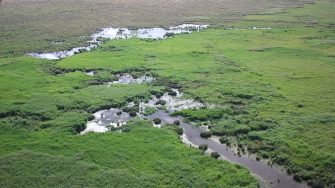
Date: Sunday, November 16, 2014
Project: Eastern Australian Waterbird Survey
Observer: Richard Kingsford
Thankfully Saturday’s heat was gone but there was a howling southwesterly wind, just what we didn’t really want going west. First we ‘mopped up’ surveying a couple of small wetland areas around the Gwydir before we headed west for the Paroo. In a wet year, we would have surveyed Narran Lake and Yantabulla Swamp but they were both dry. We chugged along about 100 knots across the Culgoa and Warrego Rivers.
Our destination was Currawinya Lakes on the Paroo River. These magnificent wetlands within Currawinya Lakes are one of my favourite system of wetlands in Australia. It’s not just because they often have more than 100,000 waterbirds but they are so different. There is a freshwater lake, Lake Numalla, and a salt lake, Lake Wyara, side by side but with quite different ecologies.
Starting our survey on Lake Numalla
Lake Wyara was bone dry and Lake Numalla was drying back considerably from last year, perhaps only 70-80% of its full area.
Water on Lake Numalla was confined the middle of the lake, with the margins dry on both sides
There were relatively few birds on Lake Numalla which surprised me. I thought with so little water around, they would have really clumped on this lake. There were possibly only a few thousand compared to the tens of thousands in 2013 on this lake.
Surveying up one of the arms on Lake Numalla
There were still plenty of cormorants on the lake and probably more than a thousand grey teal but even the diversity was not particularly high for one of the most important and diverse lakes in Australia.
Grey teal and pied stilts were feeding along the margins of Lake Numalla
We refuelled in Bourke and headed southeast to do ten transects across the Macquarie Marshes. This massive wetland probably stretches over about 80 km, north to south, and 20 km wide. We have now established 11 ‘transects’ east west across the Macquarie Marshes.
Most of the reed bed areas in the northern part of the Macquarie Marshes were dry with a few channels with environmental flow
Much of the northern part of the Marshes had very little water but as we got further south we started to pick up the tell tale sign of the environmental flow and how much it makes a difference.
Flooding in the southern part of the Macquarie Marshes with environmental flows
There were ducks, egret and herons clustered around the water which was making its way north. As the flood creeps across the dry landscape it triggers the hatching of hundreds of thousands of invertebrates and germinates plants which drive the whole food web. The waterbirds, fish, turtles and frogs come in because they food sources are so rich.
Sun catching the environmental flow creeping across the Macquarie Marshes
